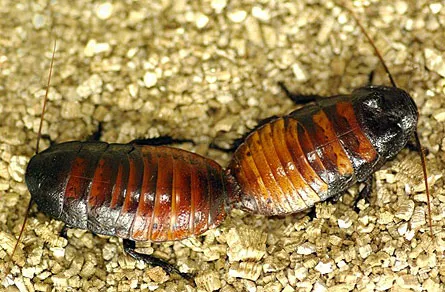SNOWBIRD, UTAH — A flirty little hiss for a guy could mean a male hissing cockroach is going to be quite popular with the ladies too.

And he’s likely to have lots of kids.
In a lab test, some 20 percent of male giant hissing roaches went romantic when they met another male, says David Logue of the University of Lethbridge in Canada. Males can’t actually mate, but flirtatious Gromphadorhina portentosa males, some outweighing a mouse, hissed gently and made the thrusting gestures of courtship among male roachkind.
Same-sex courters had no objection to females and, given a chance, courted them with unusual ardor. These linked tendencies, flirting with males and wowing females, define a behavioral syndrome, Logue said at the Animal Behavior Society meeting held in Snowbird, Utah, this week. That link, he speculated, may end up explaining the evolutionary puzzle of male flirtation among roaches.
Exploring links between behaviors, or behavioral syndromes, can reveal complexities of evolution. One part of a syndrome could supercharge a species’ fitness, but another part might have a different effect. It might drive the animal to expend energy in futile pursuits or even do something just plain dumb.
Logue and his colleagues are analyzing cockroaches to see if they have any behavioral syndromes. The link between the male flirtation and the intense courtship of females is what Logue calls the libido syndrome.
To test the results of the super-flirt syndrome, Logue let roaches mate heterosexually if they chose. Then he monitored the mated females for the three months or so of hissing roach pregnancy.
I
nstead of just laying eggs after fertilization, the hissing roaches extrude their egg case only temporarily. “It looks like a string of yellow pearls,” Logue says. Females reposition the egg string and retract it into a pouch. Months later, mom gives birth to dozens of little ones, baby- white roaches that turn brown in a few hours.Broods of baby roaches tended to be larger if the dad had shown a taste for courting other males, Logue said.
Maybe this abundance of young could end up explaining how male courtship persists, Logue says. So far, he says, he doesn’t see a benefit for it in its own right, but perhaps evolutionary forces have favored the male-female part of the syndrome and the male-male flirtation survives as spillover.
Let’s not declare anything a dubious spillover too fast, cautions behavioral ecologist Jeff Lucas of PurdueUniversity in West Lafayette, Ind. Behaviors puzzling to human eyes can turn out to have important silver linings. Female couplings among certain weevils have turned out to enhance reproduction, as the activity attracts the interest of high-quality males.
Logue agrees that he needs to check for possible benefits to male courtship before claiming it’s a nonadaptive spillover of the libido syndrome.
Even if the syndrome isn’t an odd spillover, if both parts of the syndrome have their own benefits, Lucas says, “that could be just as interesting.”






